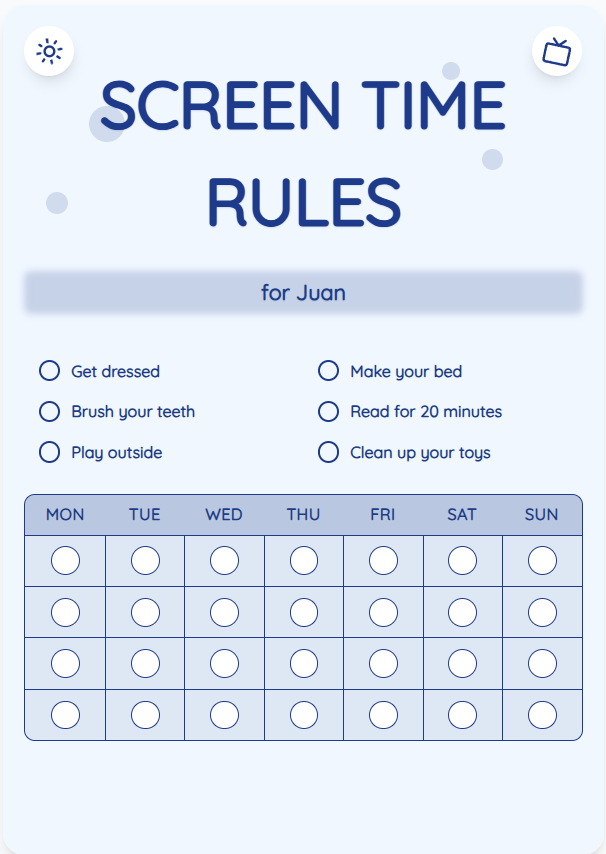Finding the Right Balance: How Much Screen Time is Healthy for Your Child?
As a parent, navigating the digital landscape can be challenging. Balancing your child's screen time with other activities is crucial for their overall well-being. In this guide, we provide expert advice and practical solutions to help you determine the healthy amount of screen time for your children aged 2-12.
See What Your Screen Time Chart Will Look Like
Here's an example of a beautiful, customizable screen time rules chart you can create for your family

Understanding Screen Time Guidelines
The American Academy of Pediatrics recommends that children aged 2 to 5 should have no more than one hour of screen time per day, focusing on high-quality educational content. For children aged 6 and older, consistent limits on screen time are also advised, with clear boundaries set by parents to ensure a healthy balance.
Creating a Family Screen Time Plan
Developing a family screen time plan can help establish routines and expectations around technology use. Set specific rules for when and where screens can be used, encourage breaks for physical activity and face-to-face interactions, and involve your child in creating the plan to promote accountability.
Put These Tips Into Action
Create a custom chart to implement these strategies with your child
Exploring Screen Time Alternatives
Encourage your child to engage in a variety of activities beyond screens, such as outdoor play, reading, arts and crafts, or family time. Provide them with screen-free options that stimulate creativity, critical thinking, and social skills to ensure a well-rounded development.
Practical Tips for Success
- Set specific screen time limits based on your child's age and individual needs.
- Use screen time charts as visual aids to help your child understand and follow the rules.
- Create tech-free zones in your home, such as the dining area or bedrooms, to promote healthy habits.
- Model positive screen time behavior by limiting your own device use in front of your child.
Frequently Asked Questions
Can educational screen time be beneficial for children?
Yes, educational content can offer valuable learning experiences when used in moderation and balanced with other activities. Be mindful of the quality of the content and ensure it aligns with your child's developmental stage.
How can I handle resistance when enforcing screen time limits?
Communicate openly with your child about the reasons behind the rules. Offer alternative activities or incentives to make the transition smoother. Consistency and positive reinforcement can help establish healthy screen time habits.
What are the signs of excessive screen time in children?
Warning signs include irritability when screen time is interrupted, difficulty focusing on non-screen activities, disrupted sleep patterns, and withdrawal from social interactions. Monitor your child's behavior to identify any negative effects of excessive screen use.
Finding the right balance for your child's screen time is essential for their overall development and well-being. By following expert guidelines, creating a family plan, and exploring screen time alternatives, you can promote a healthy relationship with technology. Visit ScreenTimeRules.com for customizable screen time charts and tools to support your journey towards a harmonious tech-life balance.
Ready to Transform Your Family's Screen Time?
Join thousands of parents who have successfully managed screen time with our customizable charts.
